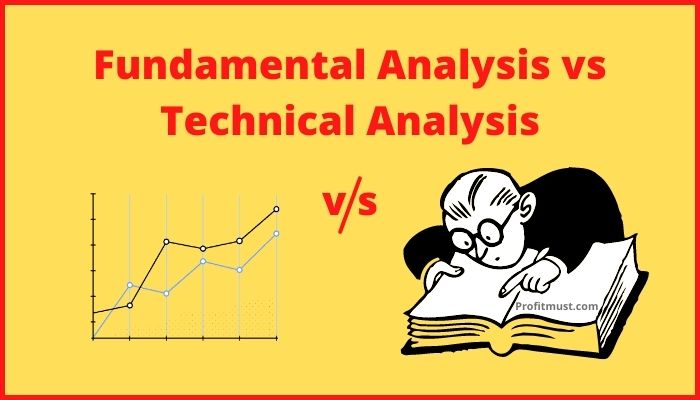When it comes to analysing the capital markets, Investors always wish to compare Fundamental Analysis vs Technical Analysis. Let’s take a closer look at both of these approaches:
Table of Contents
Fundamental Analysis vs Technical Analysis
Technical analysis studies a stock’s price volatility and attempts to forecast future price trends using this information. However, fundamental analysis studies the economic and financial aspects that drive a firm. Both have supporters and opponents, just like any other investment technique or philosophy.
Difference between Fundamental and Technical Analysis
Here are the key difference between technical vs fundamental analysis:
| Basis | Fundamental Analysis | Technical Analysis |
| Definition | Fundamental analysis is the process of evaluating stocks by assessing the stock’s fundamental valuation. | Technical analysis is a process of predicting the stock’s future price by examining charts for patterns and trends. |
| Used By | Long Term Investor | Day Trader & Short Term Investor |
| Suitable for | Investing | Trading |
| Goal | To determine the stock’s actual worth. | To determine when the best timing is to enter or exit the trade. |
| Based on | Actions are made based on the data and statistics available. | Market movements and stock movements are used to take actions. |
| Relies on | Data from the past as well as the current. | Only data from the past is available. |
| Type of data | Economic indicators, current affairs, and industry information. | Technical indicator & chart. |
| Risk | Low risk compare Technical Analysis. | High risk compared Fundamental Analysis. |
| Skills required | This is easy to learn & less skill required. | It required much more skill to learn. |
Understanding difference between Fundamental analysis and Technical analysis
After comparing Fundamental Analysis vs Technical Analysis, Let’s Discuss the differences in detail:
-
Tools
Technical analysts usually focus on charts, whereas fundamental analysts keep an eye on the financial statements of a corporation. Fundamental analysts evaluate a firm’s income statement, balance sheet, and cash flow statement to calculate its value.
An investor attempts to determine a firm’s intrinsic worth by discounting the value of future predicted cash flows to a net present value in financial perspective. A share value that is below its intrinsic value is usually regarded as a good investment option, and vice versa.
Technical analysts think that analysing a firm’s financial filings is pointless because the stock price already contains all essential data. Therefore, the trader concentrates on reviewing the stock chart for clues as to where the price might be heading.
-
Timeframe
In principle, fundamental analysis involves a long term approach to investment, whereas technical analysis takes a short-term strategy. Fundamental analysis frequently looks at data spanning numerous quarters or years, but stock charts might be displayed in weeks, days, or even minutes.
Fundamentally minded investors may have to wait a long time, if at all, for a firm ‘s fundamental worth to be reflected in the market.
Value analysts, for instance, believe that the market is mispricing a share in the near term but that the stock’s price will correct itself in the long term. In other circumstances, this “long run” can refer to a period of several years.
-
Data
Fundamental analysts also concentrate on quarterly financial filings, as well as changes in earnings per share that do not appear on a daily basis, along with price and volume data.
Admittedly, a corporation cannot make major changes overnight, and developing new products, marketing campaigns, and other methods to turn a business around or enhance it takes time.
Since the data fundamental analysts need to study a stock is generated considerably more gradually than the price and volume data utilized by technical analysts, fundamental analysts use a long-term period.
-
Approach
The objectives of technical and fundamental analysis are usually quite different. Fundamental analysts aim to make long-term investments in a firm’s actual business, whereas technical analysts attempt to find multiple short- to medium-term transactions where they can flip a share.
Comparing it to someone buying a home for lifetime to flip versus somebody purchasing a room to live in for a few days is a good way to view the contrast.
Fundamental Analysis and Its factors
The term “fundamental analysis” refers to a thorough assessment of the fundamental variables that drive the economy, industry, and company’s goals. Its goal is to determine a share’s true intrinsic value by analysing economic, financial, and other elements (both subjective and statistical) to find areas where the stock’s value differs from its present market price.

Factors
Fundamental analysis evaluates all elements that have the potential to influence the price of a stock (containing overall and organization-specific aspects), referred to as fundamentals, which include financial statements, management, competition, business model, and so on.
Its goal is to examine the entire economy, the sector to which it belongs, the business climate, and the company itself.
It is predicated on the idea that these fundamentals have some lag in impacting stock value. So, in the short run, share prices do not reflect their value, but in the long run, they do. It’s a three-phase process that includes:
-
Economy
Analyze the nation ‘s overall economic status and situation. Economic indicators are used to examine it.
-
Sector
With the use of competitive sector analysis and sector life cycle analysis, estimate the possibilities of different business classifications.
-
Firm
To determine whether to buy, sell, or hold the corporation ‘s stock, you must first determine the firm’s financial and non-financial features. Sales, profitability, and EPS, as well as management, company identity, and customer satisfaction, are assessed for this objective. You can find financial data of any listed frim on BSE website.
Technical Analysis & Its Tools
Technical analysis is employed to predict the price of a stock, and it states that the price of a stock is influenced by the interplay of demand and supply factors in the market.
It is used to predict the share ‘s future market rate based on the stock’s previous performance information. First, the swings in the share price are determined in order to determine how the price will fluctuate in the future.
The rate at which the buyer and seller of the stock agree to complete the transaction is one such value that gathers, balances, and represents all of the considerations, and is the only value that matters.
Tools
To put it another way, technical analysis provides a detailed and complete picture of the reasons for price fluctuations in a stock.

It is centered on the assumption that share prices move in patterns, i.e. upward or downward, depending on the traders’ attitude, psychology, and emotion. The following are the most important tools for technical analysis:
-
Rate
The variation in the value of stocks is reflected in the investor’s mindset as well as the supply and demand for stocks.
-
Duration
The degree of price fluctuations is a function of time, i.e. the amount of time it takes to reverse a trend determines the price variation.
-
Trade volume
The transaction volume that characterises the shift can reveal the degree of price fluctuations. If there is a fluctuation in the price of stocks but just a slight change in the transaction volume, the variation can be said to be insignificant.
-
width
The quality of a price shift is determined by determining whether the trend is distributed over several sectors or is limited to a few stocks. It represents the extent to which price fluctuations in stocks have occurred in the market as a result of the overall pattern.
Criticism
Many opponents regard technical analysis as either unsubstantiated or biased imagination at worst. Do not be shocked if these opponents challenge the profession’s authenticity to the point of mocking supporters.
Whereas most Market Analysts emphasize on the fundamentals, many companies also hire technical analysts. The Efficient Market Hypothesis (EMH), which asserts that any historical trading data is already represented in the stock price, has been the source of much technical analysis criticism.
The “strong form efficiency” concept, taken to its logical conclusion, asserts that both technical and fundamental analysis are pointless because all market data is reflected in a share ‘s price.
Technical vs fundamental analysis Which is more profitable?
Although technical and fundamental analysis are frequently considered as diametrically opposed methodologies to assessing securities, some analysts have found success by combining the two.
An analyst might, for example, employ fundamental analysis to uncover an undervalued stock and technical analysis to determine a specific entry and exit point for the investment.
When a security is significantly oversold and initiating the position too early could be detrimental, this pairing may perform best. Some purely technical traders, on the other hand, will use fundamentals to back up their trade.
A trader can be looking for a breakout near an earnings report and looking at the fundamentals to see if the company is going to outperform earnings.

Conclusion
Frequently Asked Questions About fundamental vs technical analysis
Which is better fundamental analysis or technical analysis?
Fundamental analysis is more academic in nature because it aims to establish a security's actual long-term worth. Technical analysis is more practical since it analyses markets and financial assets as they are, even if trade activity looks to be illogical at times.
Does Warren Buffett use technical analysis?
No, he doesn't use charts to make his investment decisions. In one interview, he even suggested that no stock market knowledge is required for long-term investing.
What is fundamental & technical analysis?
Fundamental analysis attempts to determine the intrinsic worth of stocks. Traders use trends and patterns in the stock's price and volume in technical analysis, which differs from fundamental analysis. For analyzing and projecting future patterns in stock values, both methodologies are employed.
How can you compare fundamental and technical analysis?
The investment purpose is handled by fundamental analysis, while the trading element is handled by technical analysis. Technical analysis is undertaken by examining price fluctuations and patterns displayed on charts, and fundamental analysis is performed by analysing many economic elements.
Is Fundamental analysis difficult?
Fundamental analysis can be time-consuming and too complex. Given the time and difficulty constraints, gaining an advantage may be tough. Markets do not necessarily follow the same path as fundamental value in the near run, therefore short-term trend typically takes precedence over fundamentals.

